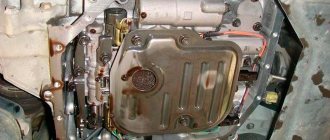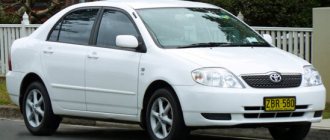In Russia, conditions for operating a car are not the easiest, few would argue with this. At the same time, most car models driving on our roads are not suitable for these same roads, primarily due to their low ground clearance.
From this article you will learn:
- What is ground clearance (ground clearance)
- The most inexpensive way to lift a car
- We increase ground clearance with spacers in the suspension
- We increase ground clearance by replacing the suspension
- Air suspension
- What does increasing ground clearance mean?
Many owners of such cars (Ford, Kia, Chevrolet, Nissan, Hyundai, Toyota) are wondering about increasing the ground clearance of their car. How possible is this and how can it be made easier?
What is ground clearance (ground clearance)
To begin with, it is worth saying that many drivers confuse the concept of ground clearance (ground clearance) and the distance from the thresholds of the car to the road surface. Ground clearance is the distance from the lowest point on the bottom of the car to the road surface. This point is not necessarily the thresholds of the car.
For most cars, the lowest point on the bottom is located at the front; this can be the front suspension elements or the engine sump (if equipped) and the gearbox. Occasionally, the lowest point may be a gearbox on the front or rear axle, or rear suspension elements.
There are different ways to increase the ground clearance of a car, some of them are very simple and not expensive for the driver, but there are also those that will require serious intervention in the car’s suspension and significant expenses. Let's consider these methods in order of increasing labor costs and cost for the driver.
It should also be noted that any method of increasing the car’s ground clearance has a number of significant disadvantages that must be taken into account before deciding to lift the car.
Increased ground clearance due to rear suspension
The rear of any vehicle experiences greater overloads than the front, and therefore sags more. To lift the rear suspension, rubber spacers for the springs are used: designed for Corolla or VAZ.
The height of spacers for the rear suspension varies depending on the condition of the car: for new ones it can be 30 mm, and for used ones that have sagged heavily, its thickness can reach 50 mm. We install them under the rear suspension springs of a Toyota Corolla in this way:
- remove the back seat of the car or at least its backrest;
- before removing the stand, loosen its central nut;
- remove the stand and disassemble it;
- the rear springs are softer, so if you work together with a partner, you don’t have to tighten them;
- We install a rubber spacer on top of the springs;
- We assemble the rack in the opposite order to disassembling it.
The most inexpensive way to lift a car
One of the easiest ways to lift your car is to install slightly larger tires than stock.
For example, instead of standard 195/60R15 tires, we install 195/65R15 tires. In the marking of this tire size, the tire profile (its height) is specified as a percentage of the width (195 mm) and is the following values:
- Tires size 195/60/R15 have a height of 117mm (60% of 195mm);
- 195/65 tires have a height of 126.7 mm (65% of 195 mm);
Here the difference in the height of these two tires is 1 cm, that is, by simply changing the size of the tires you can raise your car by 1-2 cm. If you experiment with the selection of not only tires, but also wheels, then you can add 1-2 more to the standard ground clearance cm.
Disadvantages: Installing larger non-standard tires on a car entails not only an increase in ground clearance, but also a number of disadvantages:
- The car will become more reluctant to accelerate (the diameter of the wheel becomes larger, it is more difficult for the engine to spin the wheel);
- Fuel consumption may increase noticeably (it is more difficult for the engine to spin larger wheels, the more dynamic the ride with such wheels, the more noticeable is the excess fuel consumption);
- The speedometer will show a speed lower than it actually is (the speedometer sensor reads the speed of the wheel; with a larger wheel diameter, the car travels a longer distance than the one the speedometer is set to);
- The car's odometer will show less mileage (the odometer sensor counts the number of wheel revolutions, with a larger diameter the car will travel a longer distance)
It also needs to be said that you shouldn’t get too carried away and choose tires several sizes larger than the standard ones at once, since wheels that are too large can harm the car itself. For example, they may begin to rub against the wheel arches on uneven roads or cling to the front fenders when cornering, not to mention the increased load on the car’s suspension. At most, you should take wheels 1-2 “sizes” larger than the standard ones.
This method is the most optimal if the car owner needs to lift the car temporarily, for example, only for the winter. Then in the summer, having installed standard-sized tires, the car owner again returns the car to its standard parameters.
Owner reviews
- Sergey, Vladivostok. In 2014 we bought a new car. We mainly have Japanese foreign cars, so we decided to opt for the right-hand drive Toyota Fielder 2006. The car is practically new and cost us 450 thousand rubles. We have a nice version with a silver body; the station wagon looks very impressive. The car is equipped with a CVT. The interior is nothing special, everything is decorated in the style of the early 2000s. Fuel consumption is 10 liters per 100 km. Soft and comfortable car with a large trunk. We needed a fielder for cargo transportation, as well as for trips to the country. There is enough space for five passengers in the cabin, but if necessary, the trunk can be converted into a cargo compartment by folding the rear seat backs. The engine is frankly noisy at idle and maximum speed. The suspension handles unevenness well and does not break down. The ground clearance is 160 mm, which I think is enough for a modern city car.
- Vadim, Primorsky Krai. I ordered the car from Japan. I love Japanese cars, especially from previous generations - the Japanese used to make cars with soft suspension, comfortable and roomy, just for our broken and bumpy roads. This is what my 2005 Toyota Fielder turned out to be, with a 1.5-liter engine. It has a ground clearance of 150 mm, which is the optimal figure for a station wagon. First of all, for me and our family, a spacious interior and a large trunk, cross-country ability, smooth and soft ride on country roads, reliability and convenience are important. Most of this is in Fielder, so we didn’t go wrong with the car. There are enough dynamics for the city, as well as for rough terrain. Fuel consumption 10 liters.
- Pavel, Magadan. A car for all occasions. I’m no stranger to right-hand drive cars, since we have a lot of them imported from Japan - of course, they’re mostly used junk cars, but you can find a car in good condition, or buy a “bucket” as a donor so as not to have to look for spare parts. I have a mid-spec Toyota Fielder, with a large interior and a spacious trunk - perhaps these are the main advantages for a family car. 2006 version, with robotic gearbox. I liked the solid dimensions of the interior - I was pleasantly surprised, especially considering the compact dimensions of the body. In the summer season, the car consumes 7 liters per 100 km, outside the city it turns out to be five liters, and in the urban cycle in the winter season it comes out to 10 liters per 100 km. The Toyota Fielder is a soft and quiet car, it is not capable of driving fast or cornering at high speed. This is a family option for those who need to transport cargo, children or the elderly.
We increase ground clearance with spacers in the suspension
Spacers to increase ground clearance are one of the most popular ways to raise your car. This method is relatively inexpensive, but it already requires intervention in the car’s suspension, which requires some skills (if you don’t have them, it’s better to trust a car service).
There are two types of spacers:
- Spacers that are inserted into the spring itself and do not allow 1-2 turns of the spring to compress are called “interturn”
- Spacers, which are installed under the cups of the suspension struts and allow you to raise the entire body of the car above its suspension (and above the road)
The cost of interturn spacers is relatively low and their installation does not take much time (car owners with repair experience are even quite capable of performing this procedure on their own). Interturn spacers are made of plastic, aluminum and polyurethane.
Disadvantages: Due to the restriction of the spring coils, the car's suspension becomes much stiffer, the shock absorber stroke length increases, and the car's handling may deteriorate (the price to pay for the increased ground clearance). Also, the coils of springs in places of contact with spacers may experience increased load, which is why there is a risk of their breakage. After the procedure, it is necessary to set the correct toe-in angles.
The big advantage of installing interturn spacers is that their cost is relatively low and installation is quite simple. The car owner can install them, as they say, “for testing” in order to experience for himself what it’s like to drive a car with increased ground clearance. If he doesn’t like the behavior of the car, he can remove them at any time.
For example, interturn spacers from a German manufacturer can be ordered at a discount here >>>
Spacers from another German brand that produces its products in Russia can be ordered here >>>
As for the spacers installed under the suspension cup of the car, they already imply a fairly large amount of work with the suspension. To install them, each rack must be dismantled and installed back, together with the spacer. Such work requires the presence of a lift, so it is best to install such spacers in a car service center.
Increasing ground clearance using spacers under the suspension strut cup is one of the most inexpensive, but at the same time optimal ways to raise a car, since the car’s suspension will work as normal, and the entire body will be raised a few centimeters above the suspension (and above the road) . However, this method is not without its drawbacks.
Disadvantages: Raising the car body above the suspension shifts the overall center of gravity of the car upward, which, under unfavorable circumstances, can lead to a serious rollover accident. With the ground clearance increased in this way, the driver should not heavily load the roof rack of the car, as well as test the limits of the car's capabilities by driving fast and aggressively. After the procedure, it is necessary to set the correct toe-in angles.
How to lift the front of a Toyota Corolla yourself?
The front suspension of all Toyota Corolla models is represented by classic MacPherson struts and can be improved in order to increase ground clearance.
Most often, the front of the car is raised using aluminum spacers. You can purchase a set of them specifically for the Corolla, and if they are unavailable, use aluminum ones designed for the VAZ 2108. They are ideal in size, and their bolts are shaped and threaded to fit the Toyota Corolla.
The thickness of the spacers for the front suspension should be 18-20 mm. If you choose these thicker parts, there is a risk that the right actuator will come into contact with the lever, and the left one will hang at a large angle. In addition, the camber of the wheels will change significantly with a higher rise.
Installing spacers is not difficult; all stages of this work can be completed independently:
- remove the front struts;
- be sure to tighten the springs;
- loosen the central nut and disassemble the stand (remove the upper bowl);
- we knock out the bolts that secure the rack to the body and install new ones from the kit with spacers in their place;
- assembling the stand;
- after assembly, install a spacer on top; if the spacer does not fit tightly, adjust its shape using a file;
- install the stand in place.
To increase ground clearance, in addition to installing spacers, you can also replace the front struts and front suspension springs. For these purposes, you can use spare parts from the following Corollas: all-wheel drive models with a 104 body, diesel modifications or cars with a 4A-GE engine.
We increase ground clearance by replacing the suspension
A noticeably more expensive way to lift a car is to replace the suspension springs. To make the car taller, you need to choose stiffer springs than standard ones, or longer ones. The stiffness of the springs is indicated in their markings, as well as their length.
When replacing springs, it is necessary to ensure the correct operation of the shock absorbers, which requires special devices that lengthen their attachment points, or replace the shock absorbers with longer ones. Standard shock absorbers will not be able to work properly with the car body raised above the road and will quickly fail.
Disadvantages: Installing non-standard springs and shock absorbers forces the car’s suspension to operate in maximum permissible modes, or even in conditions not intended for safe movement. After the procedure, it is necessary to set the correct toe-in angles.
Required parts and tools
In order to raise and strengthen our car, we will need a lot of spare parts, some of them are:
- More powerful springs;
- More rigid and powerful racks;
- Inserts that will be inserted between the body and the rack.
As we understand, we will need all these parts in four copies, but with the exception that the racks must match the model, and we also need to distinguish between the front and rear racks. They are slightly different from each other.
In addition, we will need a standard set of tools, which will have many heads, wrenches, spanners, etc. All of them will be required when replacing struts and springs with stiffer ones.










